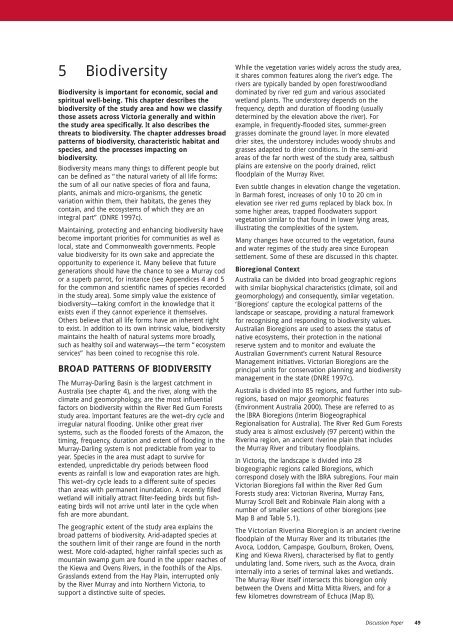Discussion Paper - Part A - Victorian Environmental Assessment ...
Discussion Paper - Part A - Victorian Environmental Assessment ...
Discussion Paper - Part A - Victorian Environmental Assessment ...
- No tags were found...
Create successful ePaper yourself
Turn your PDF publications into a flip-book with our unique Google optimized e-Paper software.
5 BiodiversityBiodiversity is important for economic, social andspiritual well-being. This chapter describes thebiodiversity of the study area and how we classifythose assets across Victoria generally and withinthe study area specifically. It also describes thethreats to biodiversity. The chapter addresses broadpatterns of biodiversity, characteristic habitat andspecies, and the processes impacting onbiodiversity.Biodiversity means many things to different people butcan be defined as “the natural variety of all life forms:the sum of all our native species of flora and fauna,plants, animals and micro-organisms, the geneticvariation within them, their habitats, the genes theycontain, and the ecosystems of which they are anintegral part” (DNRE 1997c).Maintaining, protecting and enhancing biodiversity havebecome important priorities for communities as well aslocal, state and Commonwealth governments. Peoplevalue biodiversity for its own sake and appreciate theopportunity to experience it. Many believe that futuregenerations should have the chance to see a Murray codor a superb parrot, for instance (see Appendices 4 and 5for the common and scientific names of species recordedin the study area). Some simply value the existence ofbiodiversity—taking comfort in the knowledge that itexists even if they cannot experience it themselves.Others believe that all life forms have an inherent rightto exist. In addition to its own intrinsic value, biodiversitymaintains the health of natural systems more broadly,such as healthy soil and waterways—the term “ecosystemservices” has been coined to recognise this role.BROAD PATTERNS OF BIODIVERSITYThe Murray-Darling Basin is the largest catchment inAustralia (see chapter 4), and the river, along with theclimate and geomorphology, are the most influentialfactors on biodiversity within the River Red Gum Forestsstudy area. Important features are the wet–dry cycle andirregular natural flooding. Unlike other great riversystems, such as the flooded forests of the Amazon, thetiming, frequency, duration and extent of flooding in theMurray-Darling system is not predictable from year toyear. Species in the area must adapt to survive forextended, unpredictable dry periods between floodevents as rainfall is low and evaporation rates are high.This wet–dry cycle leads to a different suite of speciesthan areas with permanent inundation. A recently filledwetland will initially attract filter-feeding birds but fisheatingbirds will not arrive until later in the cycle whenfish are more abundant.The geographic extent of the study area explains thebroad patterns of biodiversity. Arid-adapted species atthe southern limit of their range are found in the northwest. More cold-adapted, higher rainfall species such asmountain swamp gum are found in the upper reaches ofthe Kiewa and Ovens Rivers, in the foothills of the Alps.Grasslands extend from the Hay Plain, interrupted onlyby the River Murray and into Northern Victoria, tosupport a distinctive suite of species.While the vegetation varies widely across the study area,it shares common features along the river’s edge. Therivers are typically banded by open forest/woodlanddominated by river red gum and various associatedwetland plants. The understorey depends on thefrequency, depth and duration of flooding (usuallydetermined by the elevation above the river). Forexample, in frequently-flooded sites, summer-greengrasses dominate the ground layer. In more elevateddrier sites, the understorey includes woody shrubs andgrasses adapted to drier conditions. In the semi-aridareas of the far north west of the study area, saltbushplains are extensive on the poorly drained, relictfloodplain of the Murray River.Even subtle changes in elevation change the vegetation.In Barmah forest, increases of only 10 to 20 cm inelevation see river red gums replaced by black box. Insome higher areas, trapped floodwaters supportvegetation similar to that found in lower lying areas,illustrating the complexities of the system.Many changes have occurred to the vegetation, faunaand water regimes of the study area since Europeansettlement. Some of these are discussed in this chapter.Bioregional ContextAustralia can be divided into broad geographic regionswith similar biophysical characteristics (climate, soil andgeomorphology) and consequently, similar vegetation.‘Bioregions’ capture the ecological patterns of thelandscape or seascape, providing a natural frameworkfor recognising and responding to biodiversity values.Australian Bioregions are used to assess the status ofnative ecosystems, their protection in the nationalreserve system and to monitor and evaluate theAustralian Government’s current Natural ResourceManagement initiatives. <strong>Victorian</strong> Bioregions are theprincipal units for conservation planning and biodiversitymanagement in the state (DNRE 1997c).Australia is divided into 85 regions, and further into subregions,based on major geomorphic features(Environment Australia 2000). These are referred to asthe IBRA Bioregions (Interim BiogeographicalRegionalisation for Australia). The River Red Gum Forestsstudy area is almost exclusively (97 percent) within theRiverina region, an ancient riverine plain that includesthe Murray River and tributary floodplains.In Victoria, the landscape is divided into 28biogeographic regions called Bioregions, whichcorrespond closely with the IBRA subregions. Four main<strong>Victorian</strong> Bioregions fall within the River Red GumForests study area: <strong>Victorian</strong> Riverina, Murray Fans,Murray Scroll Belt and Robinvale Plain along with anumber of smaller sections of other bioregions (seeMap B and Table 5.1).The <strong>Victorian</strong> Riverina Bioregion is an ancient riverinefloodplain of the Murray River and its tributaries (theAvoca, Loddon, Campaspe, Goulburn, Broken, Ovens,King and Kiewa Rivers), characterised by flat to gentlyundulating land. Some rivers, such as the Avoca, draininternally into a series of terminal lakes and wetlands.The Murray River itself intersects this bioregion onlybetween the Ovens and Mitta Mitta Rivers, and for afew kilometres downstream of Echuca (Map B).<strong>Discussion</strong> <strong>Paper</strong>49
















